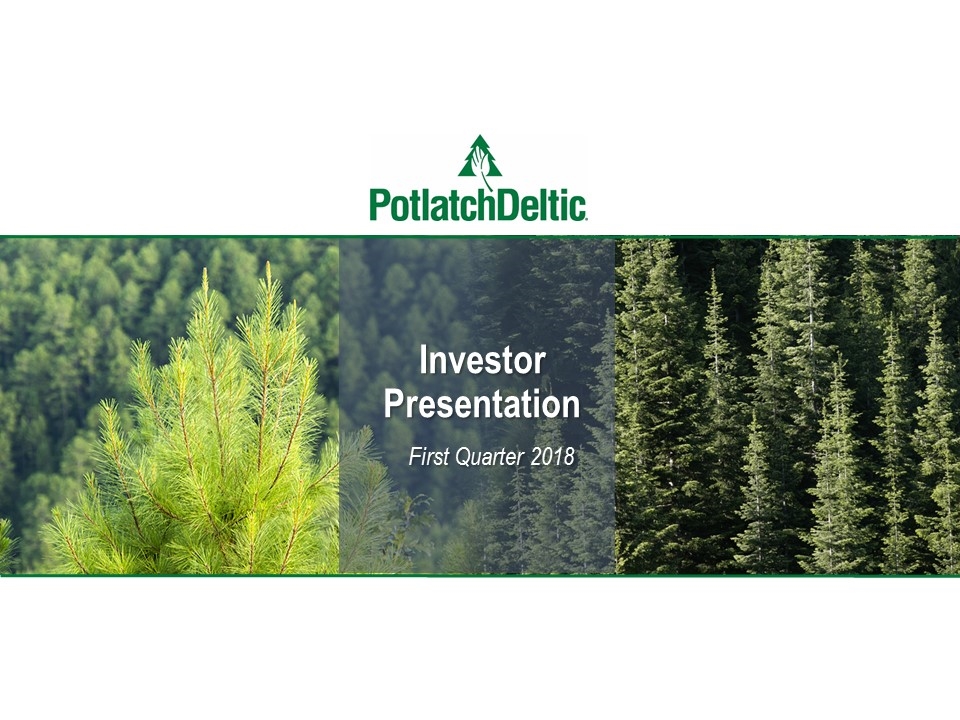
Investor Presentation First Quarter 2018
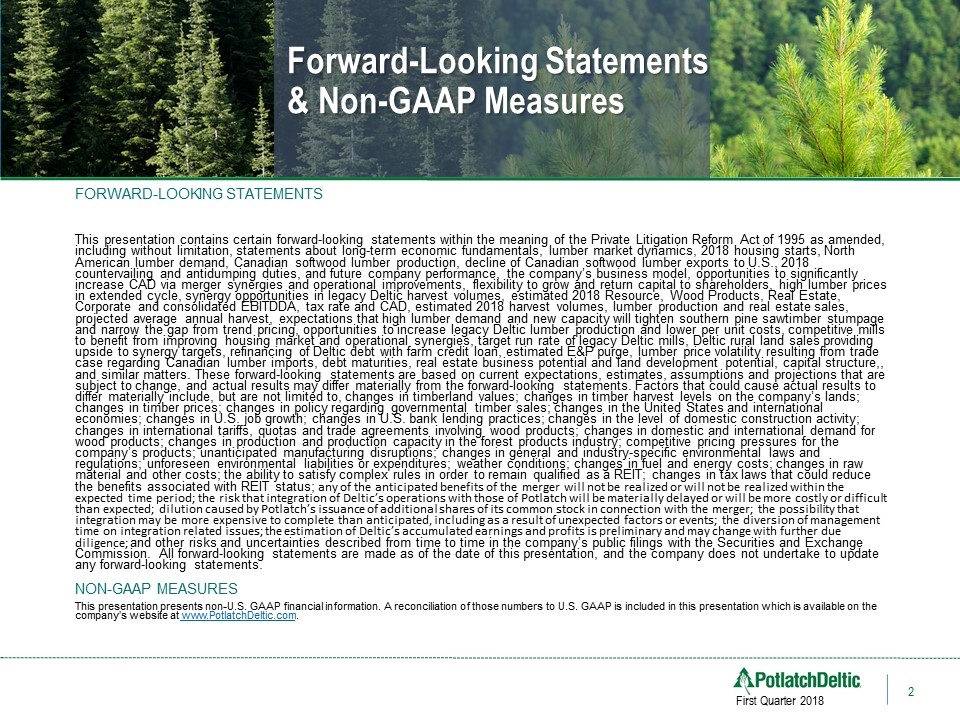
2 FORWARD-LOOKING STATEMENTS This presentation contains certain forward-looking statements within the meaning of the Private Litigation Reform Act of 1995 as amended, including without limitation, statements about long-term economic fundamentals, lumber market dynamics, 2018 housing starts, North American lumber demand, Canadian softwood lumber production, decline of Canadian softwood lumber exports to U.S., 2018 countervailing and antidumping duties, and future company performance, the company’s business model, opportunities to significantly increase CAD via merger synergies and operational improvements, flexibility to grow and return capital to shareholders, high lumber prices in extended cycle, synergy opportunities in legacy Deltic harvest volumes, estimated 2018 Resource, Wood Products, Real Estate, Corporate and consolidated EBITDDA, tax rate and CAD, estimated 2018 harvest volumes, lumber production and real estate sales, projected average annual harvest, expectations that high lumber demand and new capacity will tighten southern pine sawtimber stumpage and narrow the gap from trend pricing, opportunities to increase legacy Deltic lumber production and lower per unit costs, competitive mills to benefit from improving housing market and operational synergies, target run rate of legacy Deltic mills, Deltic rural land sales providing upside to synergy targets, refinancing of Deltic debt with farm credit loan, estimated E&P purge, lumber price volatility resulting from trade case regarding Canadian lumber imports, debt maturities, real estate business potential and land development potential, capital structure,, and similar matters. These forward-looking statements are based on current expectations, estimates, assumptions and projections that are subject to change, and actual results may differ materially from the forward-looking statements. Factors that could cause actual results to differ materially include, but are not limited to, changes in timberland values; changes in timber harvest levels on the company’s lands; changes in timber prices; changes in policy regarding governmental timber sales; changes in the United States and international economies; changes in U.S. job growth; changes in U.S. bank lending practices; changes in the level of domestic construction activity; changes in international tariffs, quotas and trade agreements involving wood products; changes in domestic and international demand for wood products; changes in production and production capacity in the forest products industry; competitive pricing pressures for the company’s products; unanticipated manufacturing disruptions; changes in general and industry-specific environmental laws and regulations; unforeseen environmental liabilities or expenditures; weather conditions; changes in fuel and energy costs; changes in raw material and other costs; the ability to satisfy complex rules in order to remain qualified as a REIT; changes in tax laws that could reduce the benefits associated with REIT status; any of the anticipated benefits of the merger will not be realized or will not be realized within the expected time period; the risk that integration of Deltic’s operations with those of Potlatch will be materially delayed or will be more costly or difficult than expected; dilution caused by Potlatch’s issuance of additional shares of its common stock in connection with the merger; the possibility that integration may be more expensive to complete than anticipated, including as a result of unexpected factors or events; the diversion of management time on integration related issues; the estimation of Deltic’s accumulated earnings and profits is preliminary and may change with further due diligence; and other risks and uncertainties described from time to time in the company’s public filings with the Securities and Exchange Commission. All forward-looking statements are made as of the date of this presentation, and the company does not undertake to update any forward-looking statements. NON-GAAP MEASURES This presentation presents non-U.S. GAAP financial information. A reconciliation of those numbers to U.S. GAAP is included in this presentation which is available on the company’s website at www.PotlatchDeltic.com. Forward-Looking Statements & Non-GAAP Measures First Quarter 2018
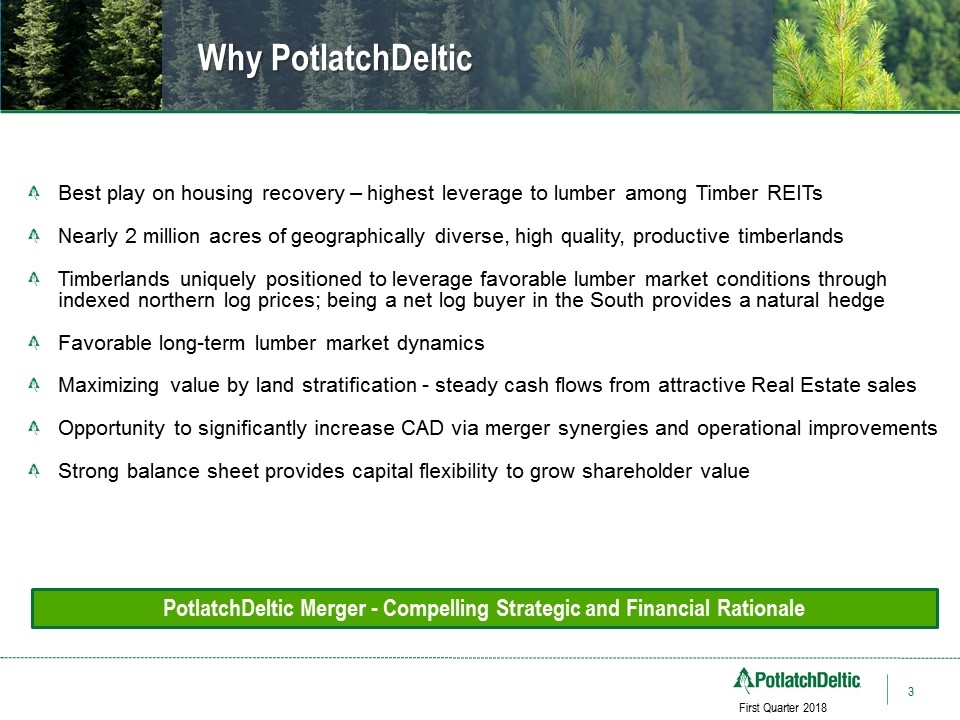
Why PotlatchDeltic Best play on housing recovery – highest leverage to lumber among Timber REITs Nearly 2 million acres of geographically diverse, high quality, productive timberlands Timberlands uniquely positioned to leverage favorable lumber market conditions through indexed northern log prices; being a net log buyer in the South provides a natural hedge Favorable long-term lumber market dynamics Maximizing value by land stratification - steady cash flows from attractive Real Estate sales Opportunity to significantly increase CAD via merger synergies and operational improvements Strong balance sheet provides capital flexibility to grow shareholder value PotlatchDeltic Merger - Compelling Strategic and Financial Rationale 3 First Quarter 2018
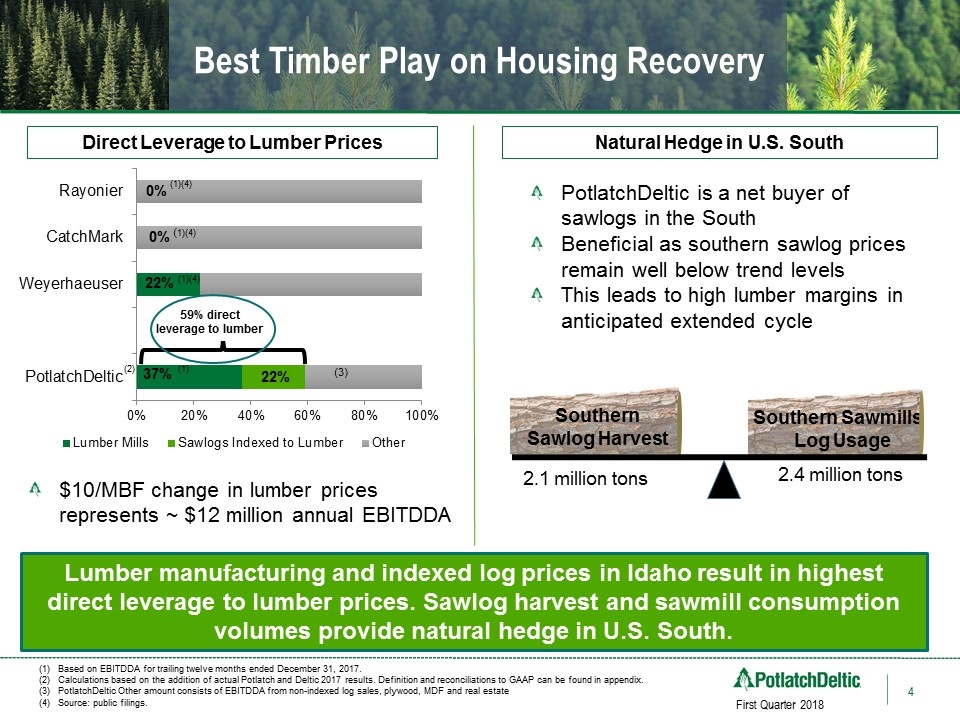
4 First Quarter 2018 Best Timber Play on Housing Recovery Direct Leverage to Lumber Prices Lumber manufacturing and indexed log prices in Idaho result in highest direct leverage to lumber prices. Sawlog harvest and sawmill consumption volumes provide natural hedge in U.S. South. 37% 22% 22% 59% direct leverage to lumber 0% 0% Based on EBITDDA for trailing twelve months ended December 31, 2017. Calculations based on the addition of actual Potlatch and Deltic 2017 results. Definition and reconciliations to GAAP can be found in appendix. PotlatchDeltic Other amount consists of EBITDDA from non-indexed log sales, plywood, MDF and real estate Source: public filings. (1) (1)(4) (1)(4) (1)(4) (3) Natural Hedge in U.S. South 2.1 million tons 2.4 million tons Southern Sawlog Harvest Southern Sawmills Log Usage PotlatchDeltic is a net buyer of sawlogs in the South Beneficial as southern sawlog prices remain well below trend levels This leads to high lumber margins in anticipated extended cycle $10/MBF change in lumber prices represents ~ $12 million annual EBITDDA (2)
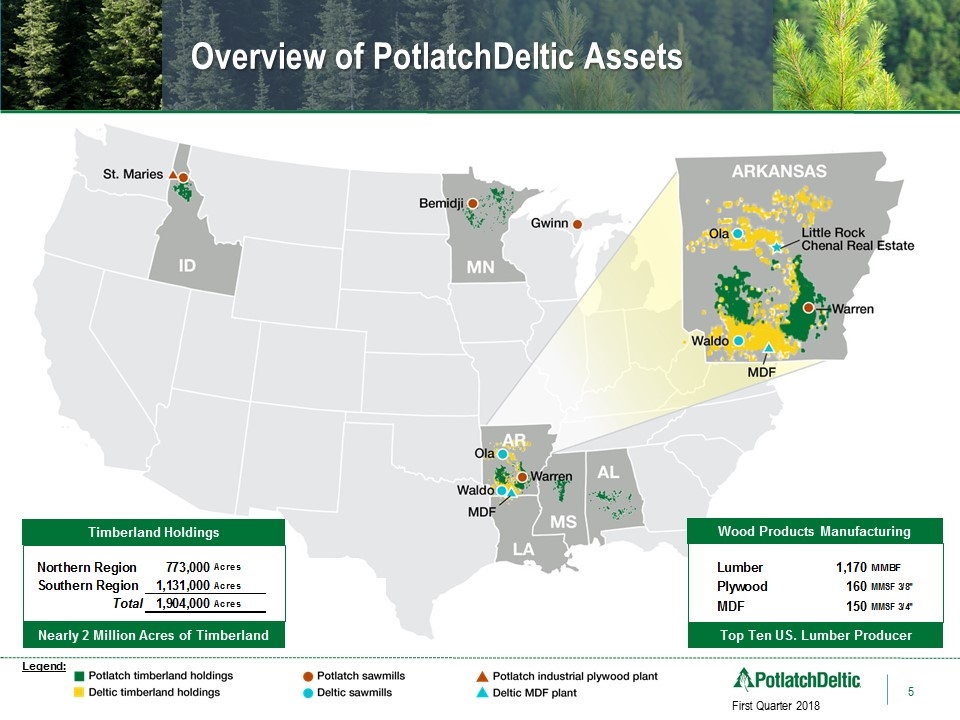
Overview of PotlatchDeltic Assets 5 Timberland Holdings Wood Products Manufacturing Top Ten US. Lumber Producer Legend: First Quarter 2018 Nearly 2 Million Acres of Timberland
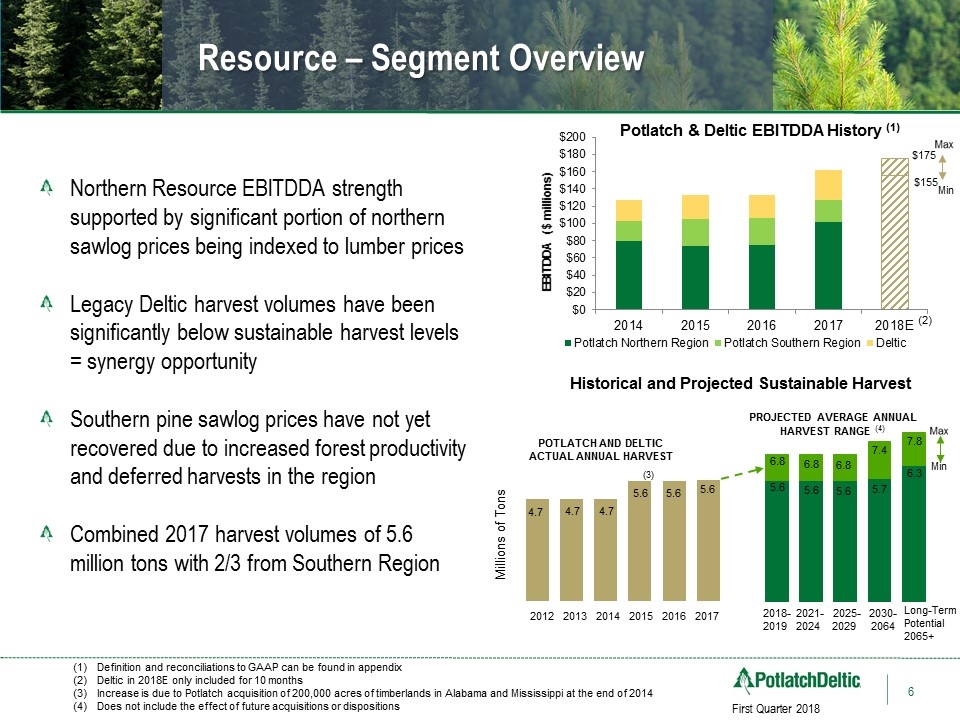
Resource – Segment Overview 6 Northern Resource EBITDDA strength supported by significant portion of northern sawlog prices being indexed to lumber prices Legacy Deltic harvest volumes have been significantly below sustainable harvest levels = synergy opportunity Southern pine sawlog prices have not yet recovered due to increased forest productivity and deferred harvests in the region Combined 2017 harvest volumes of 5.6 million tons with 2/3 from Southern Region Potlatch & Deltic EBITDDA History (1) EBITDDA ($ millions) First Quarter 2018 Historical and Projected Sustainable Harvest (3) 2012 2013 2014 2015 2016 2017 - 2021- 2025- 2030- 2024 2029 2064 POTLATCH AND DELTIC ACTUAL ANNUAL HARVEST PROJECTED AVERAGE ANNUAL HARVEST RANGE (4) Min Long-Term Potential 2065+ Definition and reconciliations to GAAP can be found in appendix Deltic in 2018E only included for 10 months Increase is due to Potlatch acquisition of 200,000 acres of timberlands in Alabama and Mississippi at the end of 2014 Does not include the effect of future acquisitions or dispositions 4.7 4.7 4.7 5.6 5.6 6.8 5.6 6.8 5.6 6.8 5.6 7.4 5.7 7.8 6.3 Millions of Tons 5.6 $155 $175 (2) Min
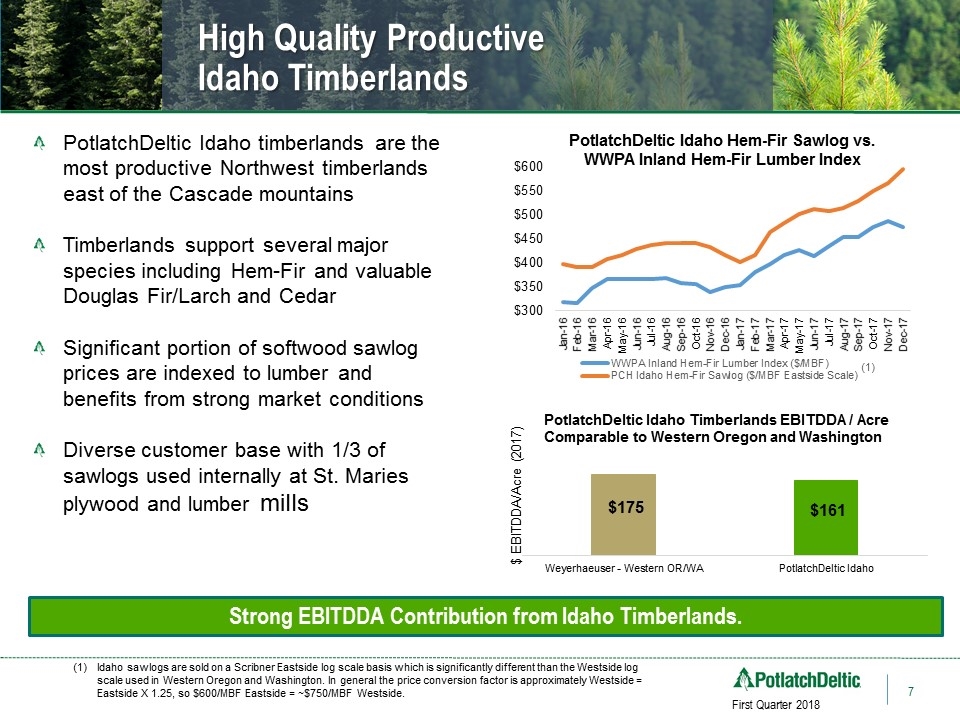
High Quality Productive Idaho Timberlands 7 PotlatchDeltic Idaho timberlands are the most productive Northwest timberlands east of the Cascade mountains Timberlands support several major species including Hem-Fir and valuable Douglas Fir/Larch and Cedar Significant portion of softwood sawlog prices are indexed to lumber and benefits from strong market conditions Diverse customer base with 1/3 of sawlogs used internally at St. Maries plywood and lumber mills PotlatchDeltic Idaho Hem-Fir Sawlog vs. WWPA Inland Hem-Fir Lumber Index Strong EBITDDA Contribution from Idaho Timberlands. First Quarter 2018 $ EBITDDA/Acre (2017) $175 $161 PotlatchDeltic Idaho Timberlands EBITDDA / Acre Comparable to Western Oregon and Washington Idaho sawlogs are sold on a Scribner Eastside log scale basis which is significantly different than the Westside log scale used in Western Oregon and Washington. In general the price conversion factor is approximately Westside = Eastside X 1.25, so $600/MBF Eastside = ~$750/MBF Westside. (1)
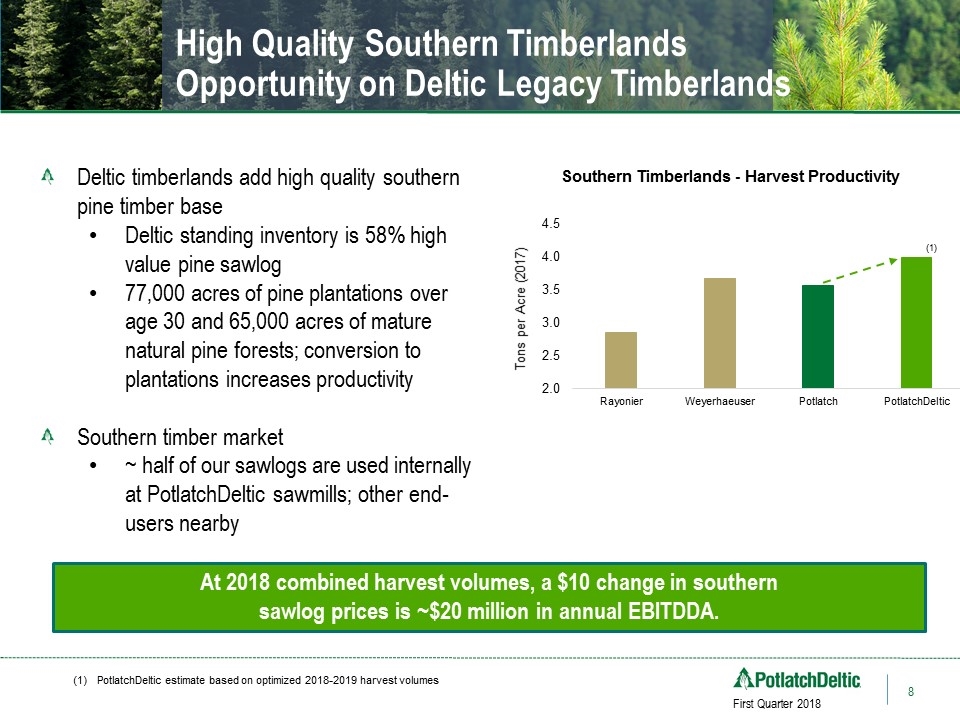
8 Deltic timberlands add high quality southern pine timber base Deltic standing inventory is 58% high value pine sawlog 77,000 acres of pine plantations over age 30 and 65,000 acres of mature natural pine forests; conversion to plantations increases productivity Southern timber market ~ half of our sawlogs are used internally at PotlatchDeltic sawmills; other end-users nearby Southern Timberlands - Harvest Productivity Tons per Acre (2017) PotlatchDeltic estimate based on optimized 2018-2019 harvest volumes High Quality Southern Timberlands Opportunity on Deltic Legacy Timberlands First Quarter 2018 (1) At 2018 combined harvest volumes, a $10 change in southern sawlog prices is ~$20 million in annual EBITDDA.
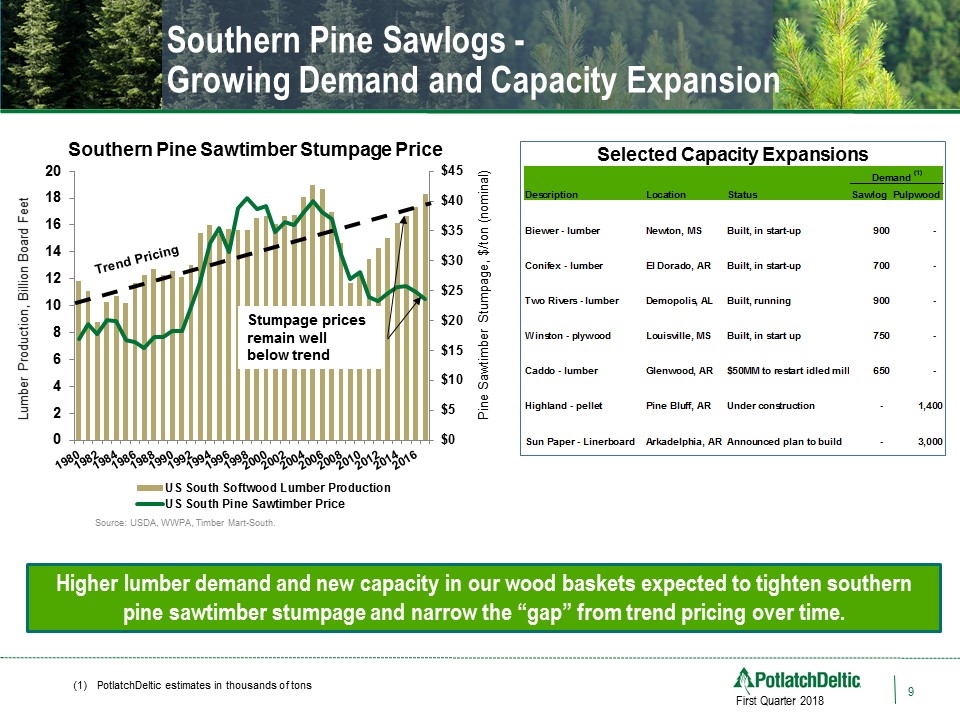
9 First Quarter 2018 Lumber Production, Billion Board Feet Pine Sawtimber Stumpage, $/ton (nominal) Trend Pricing Southern Pine Sawtimber Stumpage Price Source: USDA, WWPA, Timber Mart-South. Higher lumber demand and new capacity in our wood baskets expected to tighten southern pine sawtimber stumpage and narrow the “gap” from trend pricing over time. Stumpage prices remain well below trend Selected Capacity Expansions Southern Pine Sawlogs - Growing Demand and Capacity Expansion PotlatchDeltic estimates in thousands of tons
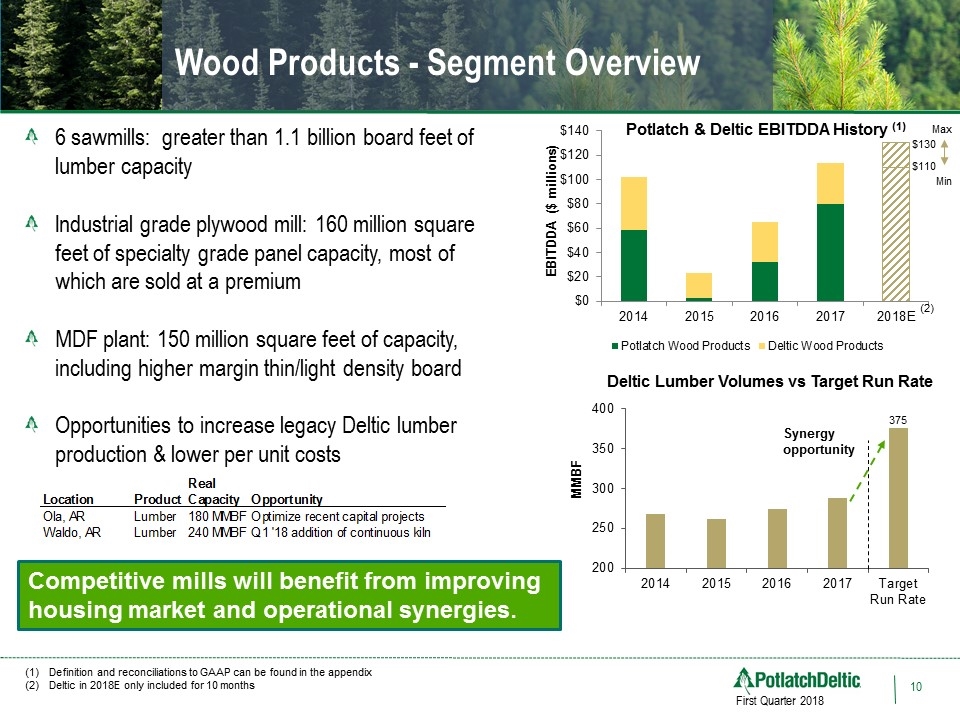
10 First Quarter 2018 6 sawmills: greater than 1.1 billion board feet of lumber capacity Industrial grade plywood mill: 160 million square feet of specialty grade panel capacity, most of which are sold at a premium MDF plant: 150 million square feet of capacity, including higher margin thin/light density board Opportunities to increase legacy Deltic lumber production & lower per unit costs EBITDDA ($ millions) Potlatch & Deltic EBITDDA History (1) Deltic Lumber Volumes vs Target Run Rate Competitive mills will benefit from improving housing market and operational synergies. MMBF Synergy opportunity Definition and reconciliations to GAAP can be found in the appendix Deltic in 2018E only included for 10 months Wood Products - Segment Overview 375 (2) $130 $110 Min Max
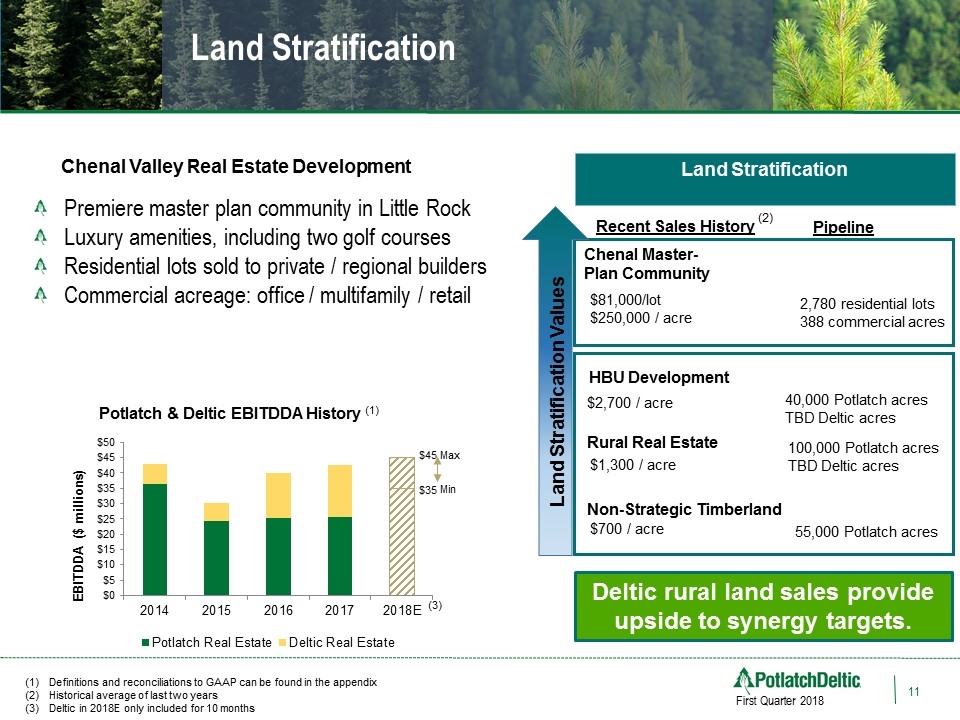
11 First Quarter 2018 Premiere master plan community in Little Rock Luxury amenities, including two golf courses Residential lots sold to private / regional builders Commercial acreage: office / multifamily / retail Land Stratification $1,300 / acre $2,700 / acre 40,000 Potlatch acres TBD Deltic acres 100,000 Potlatch acres TBD Deltic acres EBITDDA ($ millions) Potlatch & Deltic EBITDDA History (1) Deltic rural land sales provide upside to synergy targets. Definitions and reconciliations to GAAP can be found in the appendix Historical average of last two years Deltic in 2018E only included for 10 months Land Stratification HBU Development Rural Real Estate Chenal Master-Plan Community $81,000/lot $250,000 / acre 2,780 residential lots 388 commercial acres Land Stratification Values Pipeline Recent Sales History Non-Strategic Timberland $700 / acre 55,000 Potlatch acres Chenal Valley Real Estate Development (3) $45 $35 Max Min (2)
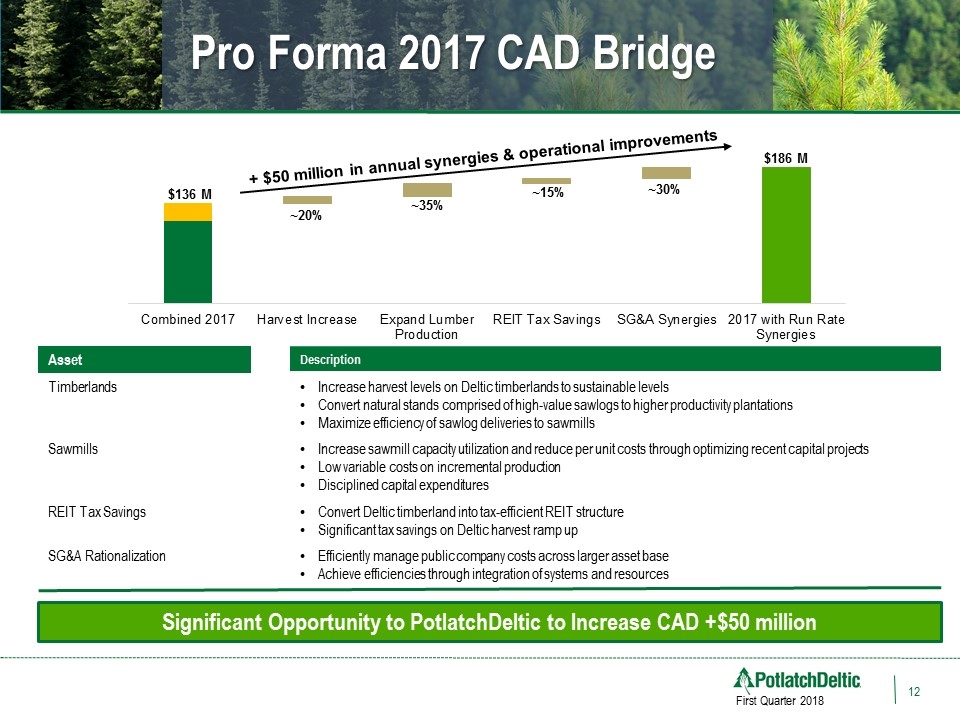
Pro Forma 2017 CAD Bridge 12 First Quarter 2018 $136 M ~20% ~35% ~15% ~30% $186 M + $50 million in annual synergies & operational improvements Asset Description Timberlands Increase harvest levels on Deltic timberlands to sustainable levels Convert natural stands comprised of high-value sawlogs to higher productivity plantations Maximize efficiency of sawlog deliveries to sawmills Sawmills Increase sawmill capacity utilization and reduce per unit costs through optimizing recent capital projects Low variable costs on incremental production Disciplined capital expenditures REIT Tax Savings Convert Deltic timberland into tax-efficient REIT structure Significant tax savings on Deltic harvest ramp up SG&A Rationalization Efficiently manage public company costs across larger asset base Achieve efficiencies through integration of systems and resources Significant Opportunity to PotlatchDeltic to Increase CAD +$50 million
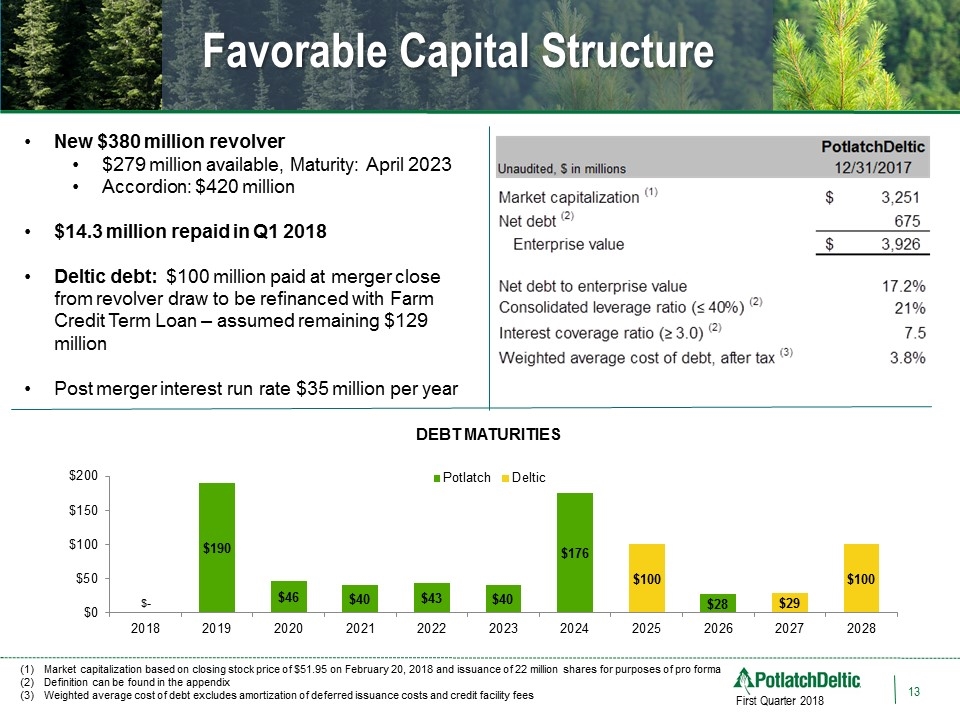
Favorable Capital Structure 13 First Quarter 2018 New $380 million revolver $279 million available, Maturity: April 2023 Accordion: $420 million $14.3 million repaid in Q1 2018 Deltic debt: $100 million paid at merger close from revolver draw to be refinanced with Farm Credit Term Loan – assumed remaining $129 million Post merger interest run rate $35 million per year DEBT MATURITIES Market capitalization based on closing stock price of $51.95 on February 20, 2018 and issuance of 22 million shares for purposes of pro forma Definition can be found in the appendix Weighted average cost of debt excludes amortization of deferred issuance costs and credit facility fees
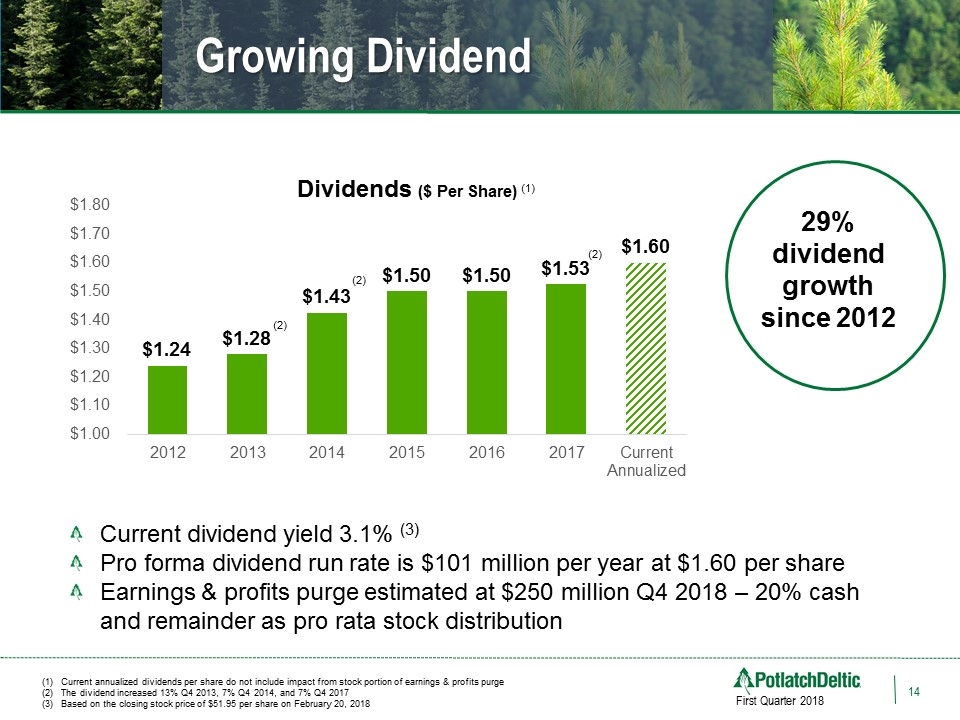
14 First Quarter 2018 Growing Dividend Dividends ($ Per Share) (1) 29% dividend growth since 2012 Current dividend yield 3.1% (3) Pro forma dividend run rate is $101 million per year at $1.60 per share Earnings & profits purge estimated at $250 million Q4 2018 – 20% cash and remainder as pro rata stock distribution Current annualized dividends per share do not include impact from stock portion of earnings & profits purge The dividend increased 13% Q4 2013, 7% Q4 2014, and 7% Q4 2017 Based on the closing stock price of $51.95 per share on February 20, 2018 (2) (2) (2)
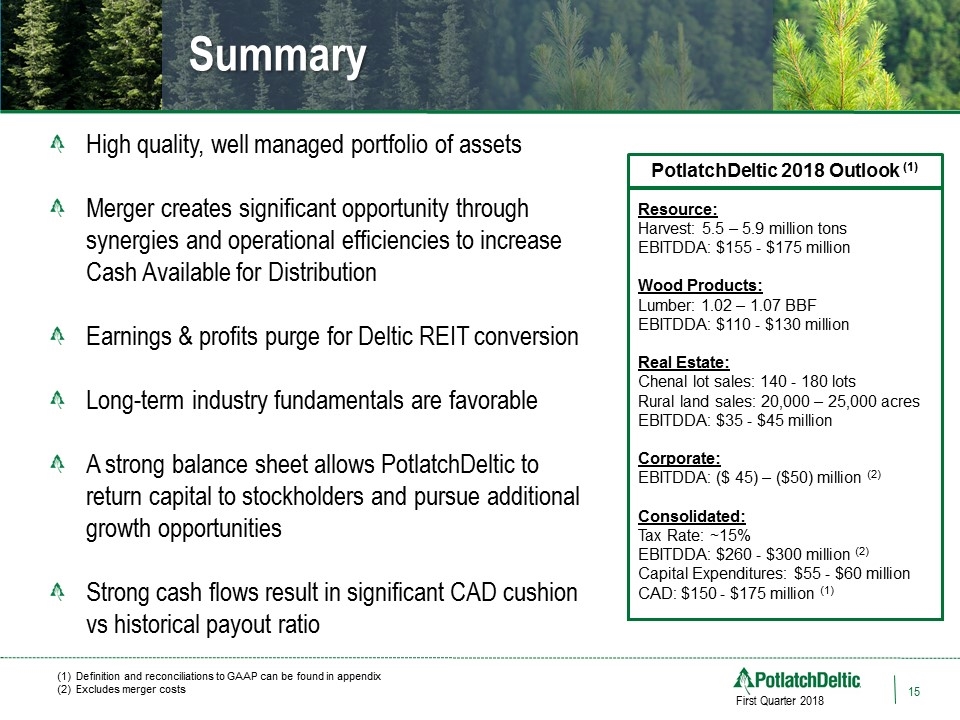
Resource: Harvest: 5.5 – 5.9 million tons EBITDDA: $155 - $175 million Wood Products: Lumber: 1.02 – 1.07 BBF EBITDDA: $110 - $130 million Real Estate: Chenal lot sales: 140 - 180 lots Rural land sales: 20,000 – 25,000 acres EBITDDA: $35 - $45 million Corporate: EBITDDA: ($ 45) – ($50) million (2) Consolidated: Tax Rate: ~15% EBITDDA: $260 - $300 million (2) Capital Expenditures: $55 - $60 million CAD: $150 - $175 million (1) Summary High quality, well managed portfolio of assets Merger creates significant opportunity through synergies and operational efficiencies to increase Cash Available for Distribution Earnings & profits purge for Deltic REIT conversion Long-term industry fundamentals are favorable A strong balance sheet allows PotlatchDeltic to return capital to stockholders and pursue additional growth opportunities Strong cash flows result in significant CAD cushion vs historical payout ratio 15 First Quarter 2018 PotlatchDeltic 2018 Outlook (1) Definition and reconciliations to GAAP can be found in appendix Excludes merger costs
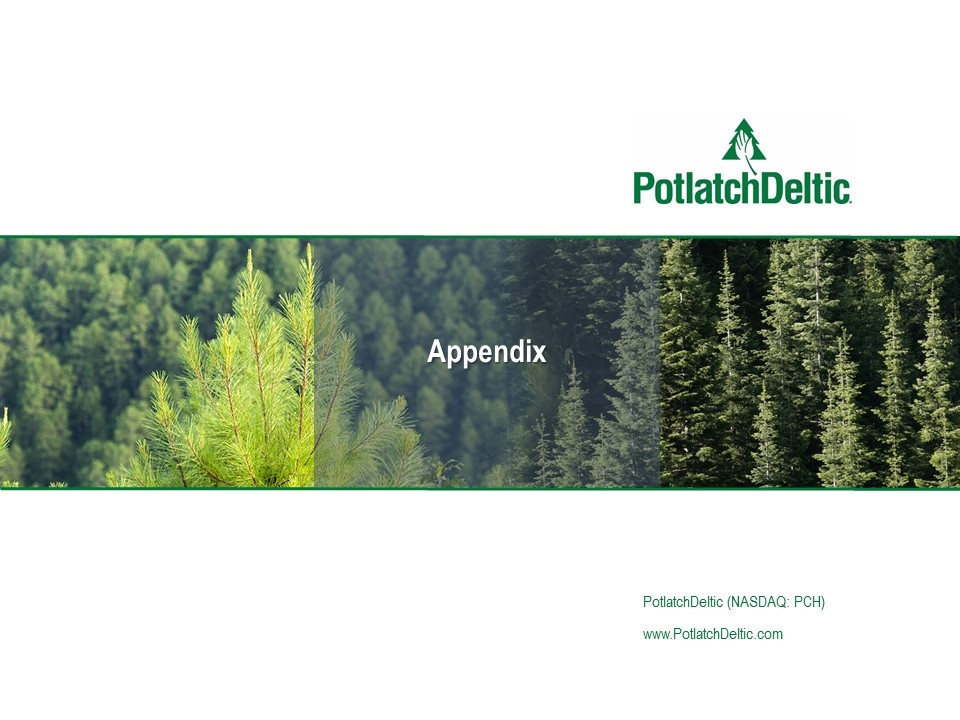
PotlatchDeltic (NASDAQ: PCH) www.PotlatchDeltic.com Appendix
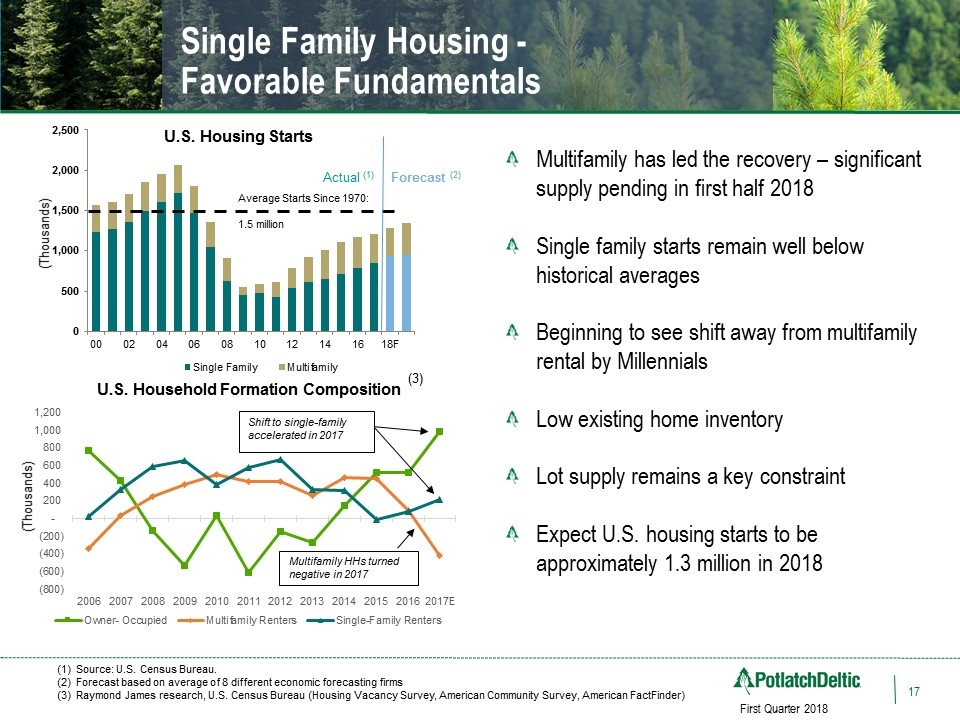
17 First Quarter 2018 Multifamily has led the recovery – significant supply pending in first half 2018 Single family starts remain well below historical averages Beginning to see shift away from multifamily rental by Millennials Low existing home inventory Lot supply remains a key constraint Expect U.S. housing starts to be approximately 1.3 million in 2018 Single Family Housing - Favorable Fundamentals Actual (1) Average Starts Since 1970: 1.5 million Source: U.S. Census Bureau. Forecast based on average of 8 different economic forecasting firms Raymond James research, U.S. Census Bureau (Housing Vacancy Survey, American Community Survey, American FactFinder) U.S. Housing Starts (Thousands) U.S. Household Formation: Owners vs Renters (3) Forecast (2) Shift to single-family accelerated in 2017 U.S. Household Formation Composition (Thousands) (3)
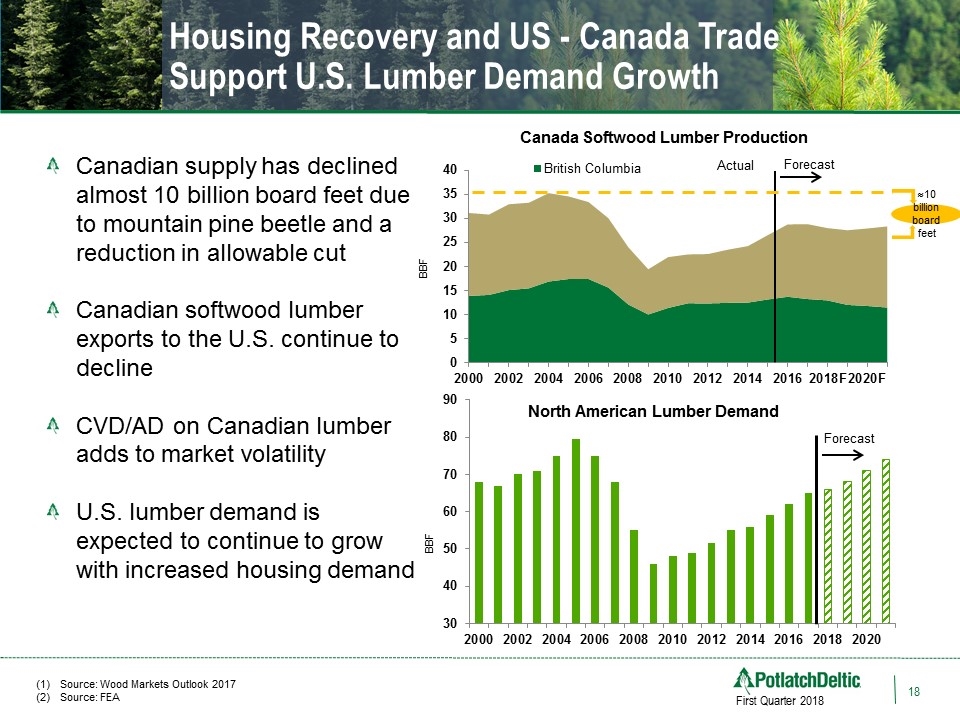
18 First Quarter 2018 Housing Recovery and US - Canada Trade Support U.S. Lumber Demand Growth Actual Forecast ≈10 billion board feet Canada Softwood Lumber Production Canadian supply has declined almost 10 billion board feet due to mountain pine beetle and a reduction in allowable cut Canadian softwood lumber exports to the U.S. continue to decline CVD/AD on Canadian lumber adds to market volatility U.S. lumber demand is expected to continue to grow with increased housing demand BBF BBF Forecast Source: Wood Markets Outlook 2017 Source: FEA North American Lumber Demand
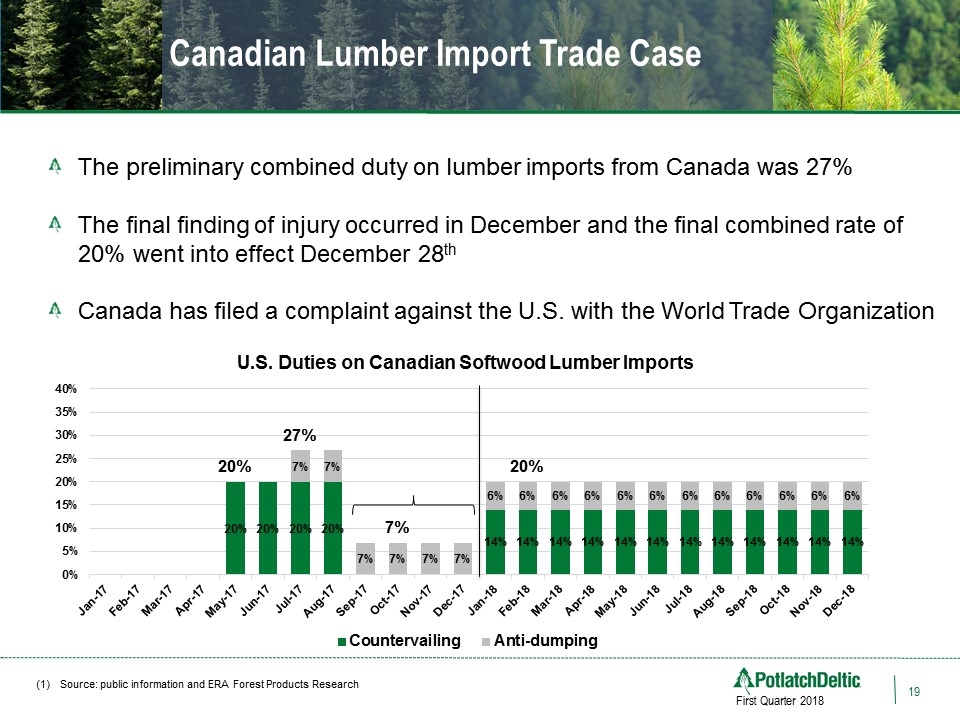
19 First Quarter 2018 Canadian Lumber Import Trade Case The preliminary combined duty on lumber imports from Canada was 27% The final finding of injury occurred in December and the final combined rate of 20% went into effect December 28th Canada has filed a complaint against the U.S. with the World Trade Organization Source: public information and ERA Forest Products Research
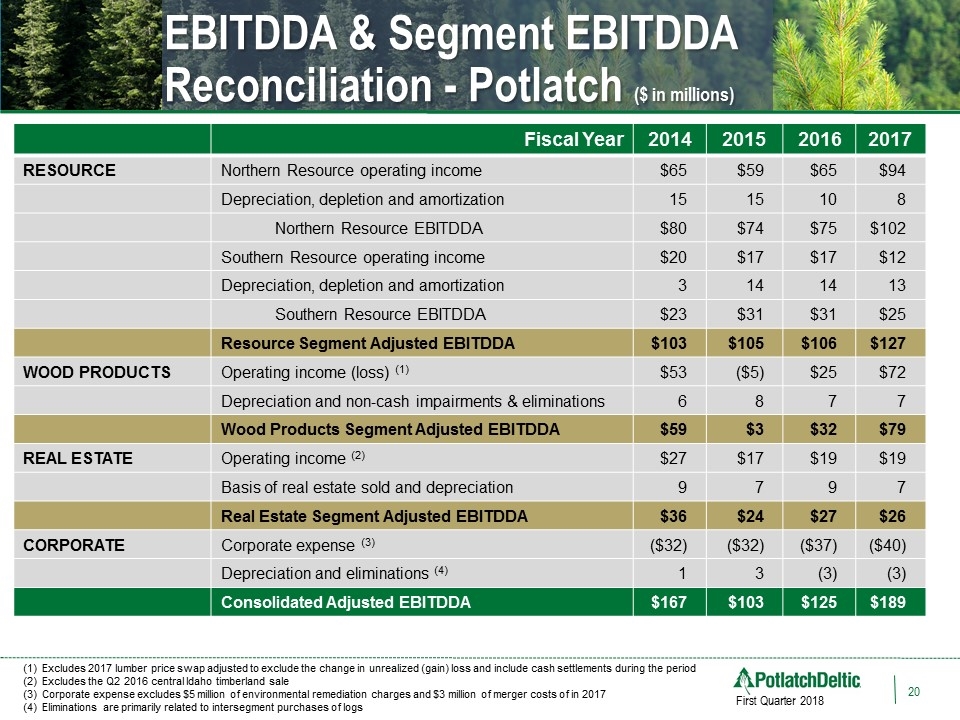
EBITDDA & Segment EBITDDA Reconciliation - Potlatch ($ in millions) 20 First Quarter 2018 Fiscal Year 2014 2015 2016 2017 RESOURCE Northern Resource operating income $65 $59 $65 $94 Depreciation, depletion and amortization 15 15 10 8 Northern Resource EBITDDA $80 $74 $75 $102 Southern Resource operating income $20 $17 $17 $12 Depreciation, depletion and amortization 3 14 14 13 Southern Resource EBITDDA $23 $31 $31 $25 Resource Segment Adjusted EBITDDA $103 $105 $106 $127 WOOD PRODUCTS Operating income (loss) (1) $53 ($5) $25 $72 Depreciation and non-cash impairments & eliminations 6 8 7 7 Wood Products Segment Adjusted EBITDDA $59 $3 $32 $79 REAL ESTATE Operating income (2) $27 $17 $19 $19 Basis of real estate sold and depreciation 9 7 9 7 Real Estate Segment Adjusted EBITDDA $36 $24 $27 $26 CORPORATE Corporate expense (3) ($32) ($32) ($37) ($40) Depreciation and eliminations (4) 1 3 (3) (3) Consolidated Adjusted EBITDDA $167 $103 $125 $189 Excludes 2017 lumber price swap adjusted to exclude the change in unrealized (gain) loss and include cash settlements during the period Excludes the Q2 2016 central Idaho timberland sale Corporate expense excludes $5 million of environmental remediation charges and $3 million of merger costs of in 2017 Eliminations are primarily related to intersegment purchases of logs
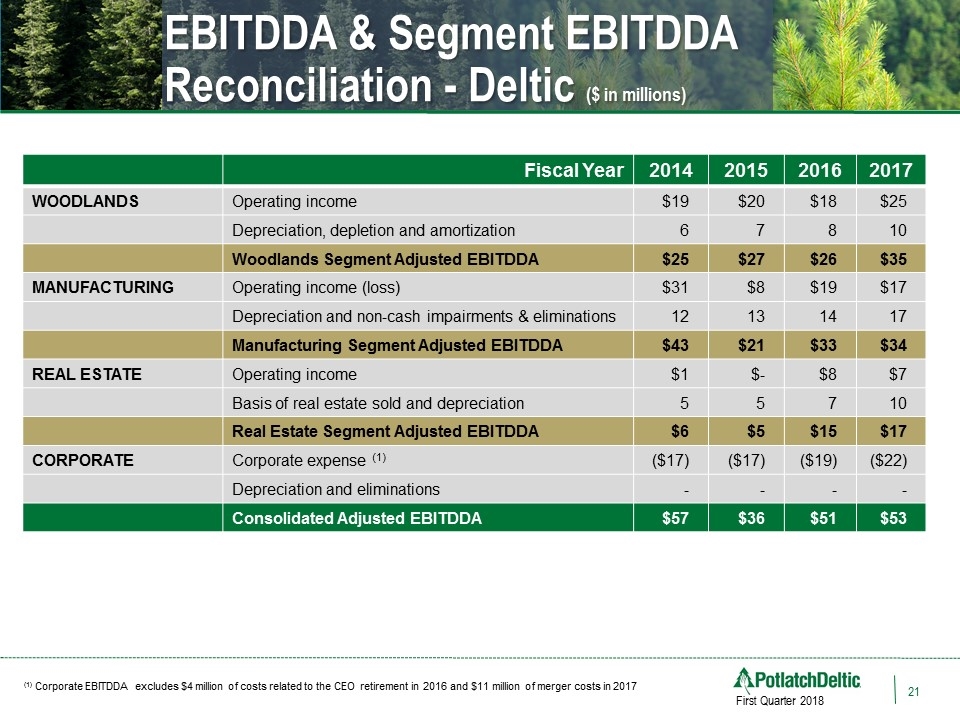
EBITDDA & Segment EBITDDA Reconciliation - Deltic ($ in millions) 21 First Quarter 2018 Fiscal Year 2014 2015 2016 2017 WOODLANDS Operating income $19 $20 $18 $25 Depreciation, depletion and amortization 6 7 8 10 Woodlands Segment Adjusted EBITDDA $25 $27 $26 $35 MANUFACTURING Operating income (loss) $31 $8 $19 $17 Depreciation and non-cash impairments & eliminations 12 13 14 17 Manufacturing Segment Adjusted EBITDDA $43 $21 $33 $34 REAL ESTATE Operating income $1 $- $8 $7 Basis of real estate sold and depreciation 5 5 7 10 Real Estate Segment Adjusted EBITDDA $6 $5 $15 $17 CORPORATE Corporate expense (1) ($17) ($17) ($19) ($22) Depreciation and eliminations - - - - Consolidated Adjusted EBITDDA $57 $36 $51 $53 (1) Corporate EBITDDA excludes $4 million of costs related to the CEO retirement in 2016 and $11 million of merger costs in 2017
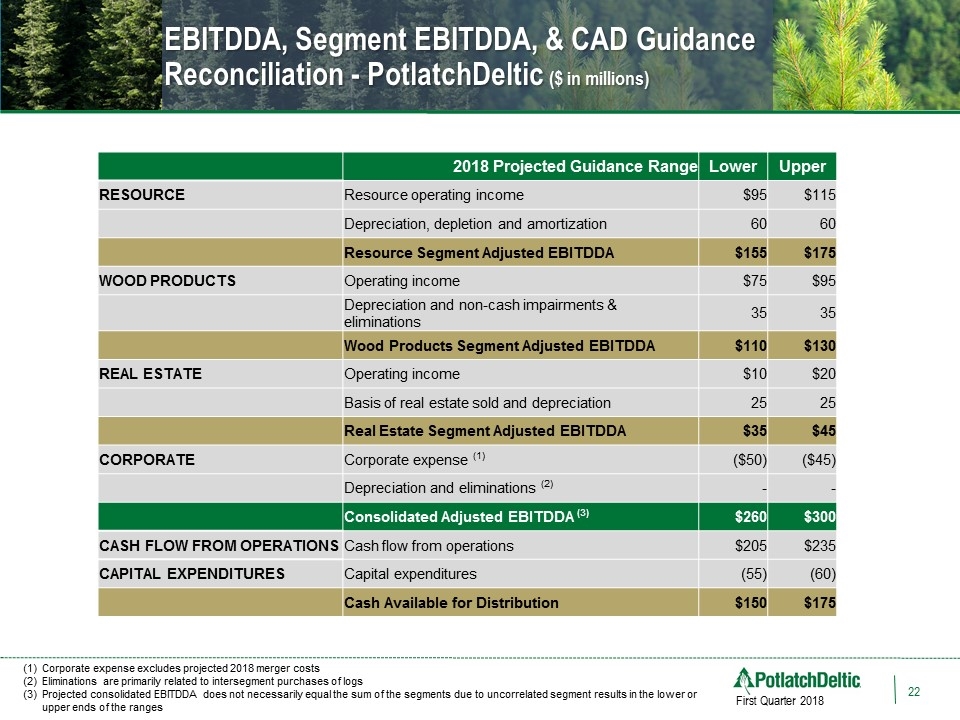
EBITDDA, Segment EBITDDA, & CAD Guidance Reconciliation - PotlatchDeltic ($ in millions) 22 First Quarter 2018 Corporate expense excludes projected 2018 merger costs Eliminations are primarily related to intersegment purchases of logs Projected consolidated EBITDDA does not necessarily equal the sum of the segments due to uncorrelated segment results in the lower or upper ends of the ranges 2018 Projected Guidance Range Lower Upper RESOURCE Resource operating income $95 $115 Depreciation, depletion and amortization 60 60 Resource Segment Adjusted EBITDDA $155 $175 WOOD PRODUCTS Operating income $75 $95 Depreciation and non-cash impairments & eliminations 35 35 Wood Products Segment Adjusted EBITDDA $110 $130 REAL ESTATE Operating income $10 $20 Basis of real estate sold and depreciation 25 25 Real Estate Segment Adjusted EBITDDA $35 $45 CORPORATE Corporate expense (1) ($50) ($45) Depreciation and eliminations (2) - - Consolidated Adjusted EBITDDA (3) $260 $300 CASH FLOW FROM OPERATIONS Cash flow from operations $205 $235 CAPITAL EXPENDITURES Capital expenditures (55) (60) Cash Available for Distribution $150 $175
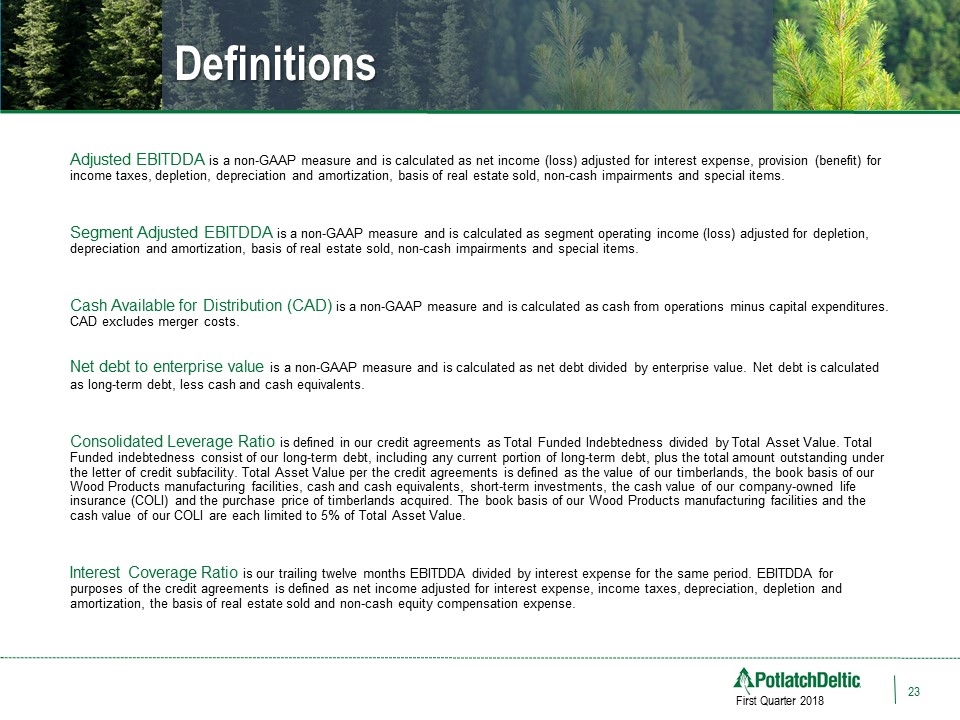
Definitions 23 First Quarter 2018 Adjusted EBITDDA is a non-GAAP measure and is calculated as net income (loss) adjusted for interest expense, provision (benefit) for income taxes, depletion, depreciation and amortization, basis of real estate sold, non-cash impairments and special items. Segment Adjusted EBITDDA is a non-GAAP measure and is calculated as segment operating income (loss) adjusted for depletion, depreciation and amortization, basis of real estate sold, non-cash impairments and special items. Cash Available for Distribution (CAD) is a non-GAAP measure and is calculated as cash from operations minus capital expenditures. CAD excludes merger costs. Net debt to enterprise value is a non-GAAP measure and is calculated as net debt divided by enterprise value. Net debt is calculated as long-term debt, less cash and cash equivalents. Consolidated Leverage Ratio is defined in our credit agreements as Total Funded Indebtedness divided by Total Asset Value. Total Funded indebtedness consist of our long-term debt, including any current portion of long-term debt, plus the total amount outstanding under the letter of credit subfacility. Total Asset Value per the credit agreements is defined as the value of our timberlands, the book basis of our Wood Products manufacturing facilities, cash and cash equivalents, short-term investments, the cash value of our company-owned life insurance (COLI) and the purchase price of timberlands acquired. The book basis of our Wood Products manufacturing facilities and the cash value of our COLI are each limited to 5% of Total Asset Value. Interest Coverage Ratio is our trailing twelve months EBITDDA divided by interest expense for the same period. EBITDDA for purposes of the credit agreements is defined as net income adjusted for interest expense, income taxes, depreciation, depletion and amortization, the basis of real estate sold and non-cash equity compensation expense.
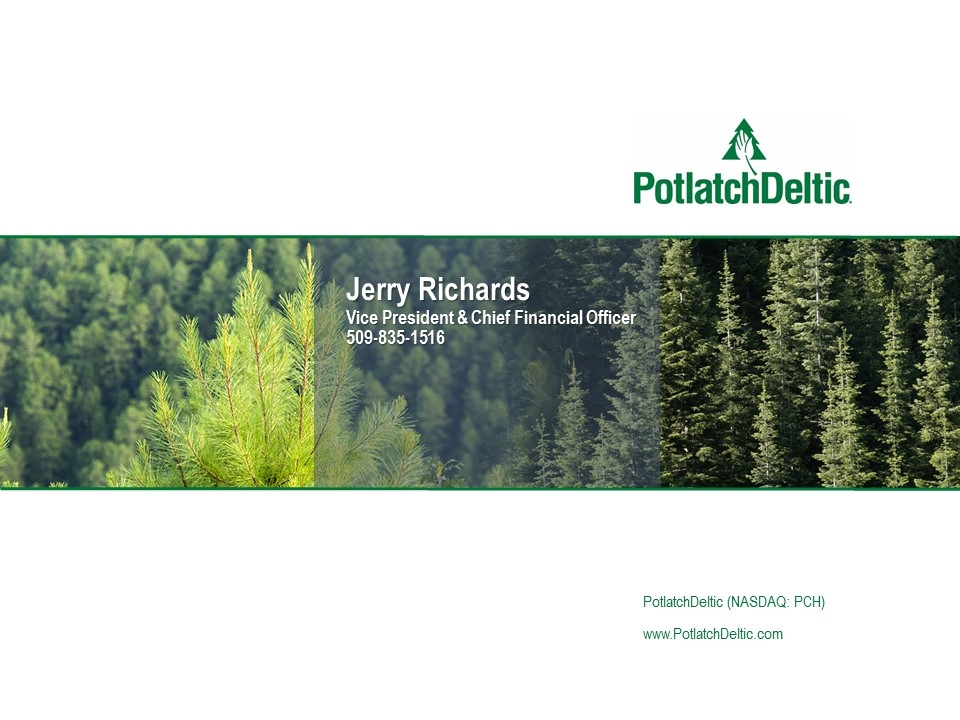
PotlatchDeltic (NASDAQ: PCH) www.PotlatchDeltic.com Jerry Richards Vice President & Chief Financial Officer 509-835-1516























